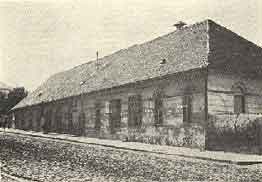|
Dimitrije Matić
Dimitrije Matić ( sr, Димитрије Матић; 18 August 1821 – 17 October 1884) was a Serbian philosopher, jurist, professor, and politician who served as Minister of Education, Minister of Justice and Minister of Foreign Affairs. He was President of the National Assembly, which ratified the 1878 Treaty of Berlin proclaiming Serbia's independence. He was a liberal-minded philosopher and politician who believed that the rule of force was unacceptable and that governments should promote and support popular education.Daskalov 2013, p. 112 A prominent lawyer, writer and translator, he helped organized the college's law school; a prominent statesman, he secured major reforms in education. Matić was a tireless worker who dedicated his life to the creation of modern Serbia. Early life and education Dimitrije Matić was born in 1821 in Ruma, the Kingdom of Slavonia, a province of the Habsburg monarchy within the Austrian Empire. His father, Iliya Matić, is said to have ... [...More Info...] [...Related Items...] OR: [Wikipedia] [Google] [Baidu] |
Kingdom Of Slavonia
The Kingdom of Slavonia ( hr, Kraljevina Slavonija, la, Regnum Sclavoniae, hu, Szlavón Királyság, german: Königreich Slawonien, sr-Cyrl, Краљевина Славонија) was a kingdom of the Habsburg monarchy and the Austrian Empire that existed from 1699 to 1868. The kingdom included northern parts of present-day regions of Slavonia (today in Croatia) and Syrmia (today in Serbia and Croatia). The southern parts of these regions were part of the Slavonian Military Frontier, which was a component of the Military Frontier separating the Habsburg monarchy from the Ottoman Empire. Geography The Kingdom of Slavonia was bounded by the Kingdom of Croatia to the west, the Kingdom of Hungary to the north and the east, and the Ottoman Empire to the south. Together with the Slavonian Military Frontier, Slavonia was about 6,600 miles squared in area. It was divided into the three counties of Požega, Virovitica and Syrmia. Besides a chain of mountains in the middle of the ... [...More Info...] [...Related Items...] OR: [Wikipedia] [Google] [Baidu] |
Alexander Karađorđević, Prince Of Serbia
Alexander Karađorđević ( sr-cyr, Александар Карађорђевић, Aleksandar Karađorđević; 11 October 1806 – 3 May 1885) was the prince of Serbia between 1842 and 1858 and a member of the House of Karađorđević. Early life The youngest son of Karageorge Petrović and Jelena Jovanović was born in Topola on 11 October 1806. He was educated in Khotin, Bessarabia (Russia), under the patronage of the Russian Tsar. After the Sultan’s decree acknowledging the title of Prince Mihailo Obrenović at the end of 1839, the family returned to Serbia. Alexander joined the Headquarters of the Serbian Army, and was promoted to the rank of Lieutenant and appointed as adjutant to Prince Mihailo. Prince of Serbia After the political conflicts caused by disrespect of the so-called "Turkish constitution," and Miloš Obrenović's and then Mihailo Obrenović's abdications, Aleksandar Karađorđević was elected the Prince of Serbia at the National Assembly in Vračar, a m ... [...More Info...] [...Related Items...] OR: [Wikipedia] [Google] [Baidu] |
National Assembly (Serbia)
The National Assembly ( sr-cyr, Народна скупштина, Narodna skupština, ) is the unicameral legislature of Serbia. The assembly is composed of 250 deputies who are proportionally elected to four-year terms by secret ballot. The assembly elects a president (speaker) who presides over the sessions. Wikisource: Constitution of Serbia The National Assembly exercises supreme legislative power. It adopts and amends the Constitution, elects Government, appoints the Governor of the National Bank of Serbia and other state officials. All decisions are made by majority vote of deputies at the session at which a majority of deputies are present, except for amending the Constitution, when a two-thirds majority is needed.National Assembly of SerbiaInformer (This text is in the public domain as the official material of the Republic of Serbia state body or a body performing public functions, under the terms of Article 6, Paragraph 2 of Serbian copyright law) The assembly convenes ... [...More Info...] [...Related Items...] OR: [Wikipedia] [Google] [Baidu] |
Sremski Karlovci
Sremski Karlovci ( sr-cyrl, Сремски Карловци, ; hu, Karlóca; tr, Karlofça) is a town and municipality located in the South Bačka District of the autonomous province of Vojvodina, Serbia. It is situated on the banks of the Danube, from Novi Sad. According to the 2011 census results, it has a population of 8,750 inhabitants. The town has traditionally been known as the seat of the Serbian Orthodox Church in the Habsburg Monarchy. It was the political and cultural capital of Serbian Vojvodina after the May Assembly and during the Revolution in 1848. Name In Serbian, the town is known as ''Sremski Karlovci'' (Сремски Карловци), in Croatian as ''Srijemski Karlovci'', in German as ''Karlowitz'' or ''Carlowitz'', in Hungarian as ''Karlóca'', in Polish as ''Karłowice'', in Romanian as ''Carloviț'' and in Turkish as ''Karlofça''. The former Serbian name used for the town was ''Karlovci'' (Карловци), which is also used today, albeit unoffi ... [...More Info...] [...Related Items...] OR: [Wikipedia] [Google] [Baidu] |



